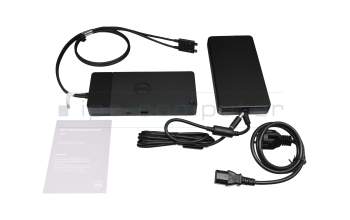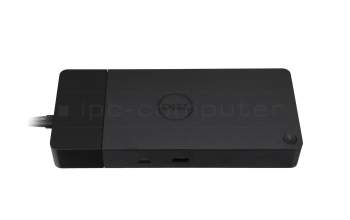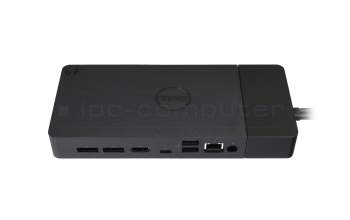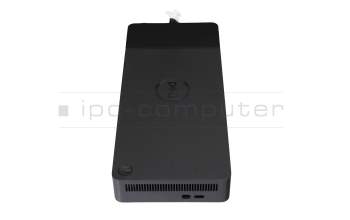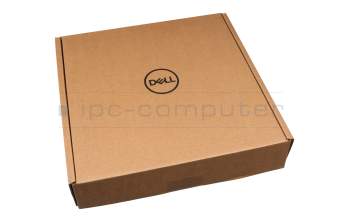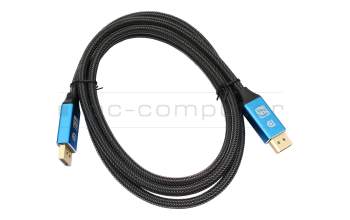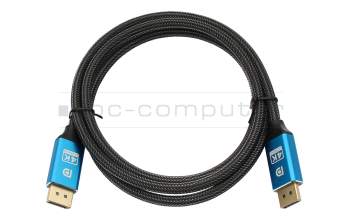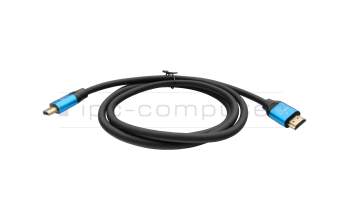Dell DELL-WD19DCS Performance Dockingstation - WD19DCS incl. 240W Netzteil Performance Dock WD19DCS - 240W

Substitute part numbers:
K20A, K20A001
- Manufacturer
- Dell
- Item Number
- DELL-WD19DCS
- Sub-Partnumbers
- K20A, K20A001
- Sicherheitsinformationen
- Sicherheits- & Herstellerkontakt-Informationen
Common data
- Condition
- New
Technical Data
- Connexion to the laptop
- Dual USB-C
- Connectors
-
1x DC-In (Power supply)
1x Ethernet (RJ-45)
1x HDMI
2x DisplayPort 1.4
2x USB-C 3.2 Gen 2
3x USB-A 3.2 Gen 2 - Delivery includes
-
AC-Adapter
Docking Station
Documentation
Power cable - Included ac-adaptor
- 240W
- Compatible operating systems
-
Linux / Ubuntu
Windows 10 (32bit/64bit)
Windows 11 - Length / Width / Hight
- 20,5 cm / 9 cm / 3 cm
Pros
Use the existing interfaces of your laptop separately. Easily connect and disconnect the ports for e.g. mouse, printer, USB in a fast and secure way. Mirroring or extending your desktop to external monitors.
Note
Please compare the wattage of the power supply belonging to your laptop with the voltage of the power supply which comes with this docking station. To use the full function of your laptop, especially under full load, the wattage of the docking station power supply should be the same or higher than the original one that comes with you laptop.
Specifications according to Dell for the power supply: 210 W power supply for Dell systems when using dual USB-C, 90 W power supply for non-Dell systems.
Supported resolutions for dual USB-C operation:
at HBR2 PC
3 x FHD @ 60Hz
3 x QHD @ 60Hz
1 x 4K @ 60Hz
at HBR3 PC
3 x FHD @ 60Hz
3 x QHD @ 60Hz
2 x 4K @ 60Hz
1 x 8K @ 30 Hz
Max. Resolution: 5120 x 2880 @ 60Hz
The maximum resolution and number of external monitors that can be used depends on your notebook / monitors. You can find out directly from the manufacturer whether your device has the required technology and connections.
Video interfaces:
2 x full size DP1.4
1 x HDMI
1 x MFDP USB-C
USB ports:
3 x USB-A 3.1 Gen 1
2 x USB-C 3.1 Gen 2
Networking:
Gigabit Ethernet
Security slot type:
1 x Kensington lock slot
1 x Noble Wedge lock slot
Supported Operating Systems:
Microsoft Windows 10
Ubuntu 04/18
Red Hat Enterprise Linux
Connection cable: 0.8m
Dimensions: 205mm x 90mm x 29mm
Management features:
PXE boot
Wake-on-LAN
MAC address pass-through
Port disablement
Wake-On-Dock button
Wake-on-Dock
Dell Command Update (DCU)
Error messages and dock event notifications
Note: WD19DCS does not have 3.5mm connectors.
Scope of delivery: Port replicator, power supply unit (240W), power cable (EU), instructions for use
Category
- Category
- Dockings
- Usage
- Laptop
- Excerpt of suitable models for P/N DELL-WD19DCS
- Dell Precision 15 (7520) , Dell Precision 17 (5750) , Dell Precision 15 (7530) , Dell Precision 15 (7540) , Dell Precision 15 (7550) , Dell Inspiron 15 (7560) , Dell Precision 17 (7730) , Dell Precision 17 (7750) , Dell XPS 17 (7760) , Dell Precision 17 (5760)
You've found this article over a part number. We'll check if it's the correct sparepart for your machine. To do this, please insert the manufacturer and the name of the model in the order comment.
Videos & Contributions
Important and useful informations about laptop Docking stations
Frequently asked questions about Docking stations
- Do docking stations work even if they can only be delivered with a stronger ac adapter?
Technically speaking, a more powerful power supply can be used without any problems and does not pose any danger to your device, as it always draws as much energy as it currently needs. The only disadvantage is the usually higher price of the more powerful product.
- Do I need special drivers for my docking station or port replicator?
In order to use your docking station or port replicator, you need the appropriate drivers. The easiest way to find these drivers is directly from the manufacturer of the docking station/port replicator. You will usually need the serial number or the exact model name.
The driver for our in-house port replicator can be found on our info page for the IPC port replicator.
- Is it possible to use an USB-C/USB-3.0 port replicator from different Manufacturers?
Yes, as general rule this is possible. Although you have to consider the power capacity and the type of the connection.
- What advantages does an USB-C port replicator/docking station grant?
The most remarkeble advantages in comparison to USB3.0, are a faster data transmission rate and the possibility to charge the device via USB-C. Also is USB-C becoming the default option for more and more devices.
- What port replicator do i require?
On the one hand you have to consider the compatibility of your device. If your laptop has no USB-C connection, it can cause problems with newer models. On the other hand the port replicator has to produce enough power and can not convert less watts than your Notebook needs. At last you can choose how many and what type of connections for peripherals you need.
All questions about Docking stations

